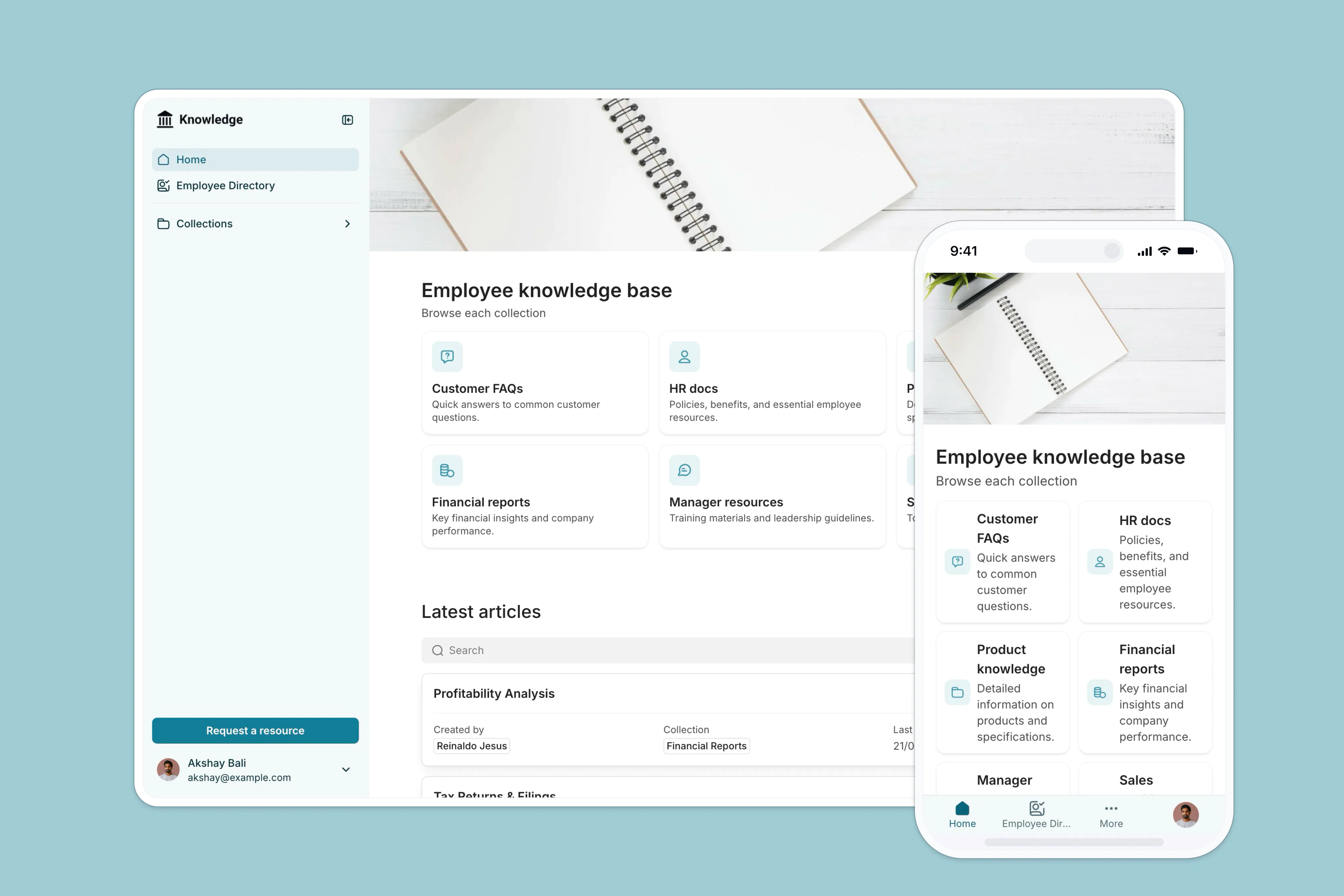What is an internal knowledge base and how to build one in 7 easy steps

Whether you’re a fast-growing startup onboarding new colleagues every other week, or an established team with a complex product, building a comprehensive internal knowledge base is a critical step to implement to make sure everyone is on the same page.
In this article, we will go over what an internal knowledge base is, the various options available to start creating your own, and the 7 steps to follow in order to build the best knowledge base possible.
Let’s dive in!
What is an internal knowledge base?
An internal knowledge base is an internal tool used by companies to document processes and resources. In other words, it can be considered as a digital library gathering all the necessary information about a business, so employees and stakeholders can find anything they need.
For example, an internal knowledge base could help team members:
- Use the product or services the company sells with guides and how-to’s
- Figure out how to file an expense for the finance team
- Understand the organisational chart and each person’s role internally
- Get a look at previous marketing campaigns results
- Follow how-to guides on how to use the internal tech stack
Different teams and companies use knowledge bases for different reasons. But ultimately, it all comes down to building a useful library of resources for the purpose of sharing knowledge internally.
You can explore building an internal knowledge base through this Softr template for a team wiki, a central hub for a company’s resources, announcements, employee directory, etc.

Why do you need an internal knowledge base?
Some organisations and teams might wonder why they need an internal knowledge base. It’s important to mention that building and maintaining it will take time and require a sound set of processes.
But there are several benefits to building a knowledge base:
- Creating the go-to resource: Documents and instructions floating around in Google Drive, Slack, Dropbox, or even exchanged through emails… Teams often rely on unscalable, unsustainable ways to store and share documentation. An internal knowledge base can change that.
- Avoiding silos: Transparency within an organisation and across teams should be encouraged to avoid miscommunication and wasted energy, and to promote cross-team collaboration.
- Facilitating onboarding: New hires should be able to jump in and have access to everything they need, without having to worry about asking someone every five minutes.
- Increasing cohesiveness: By implementing an internal knowledge base for the entire company, you’ll be able to promote a cohesive messaging and approach to problem-solving.
And the list goes on. An internal knowledge base will help you streamline much of your documentation and, if done correctly, will become a centerpiece of your operations. As your team grows, these benefits will become even more obvious.
How to build an internal knowledge base?
There are three main ways to build an internal knowledge base: coding, using a dedicated knowledge base tool, and building your own without code. Let’s look at each option individually.
Coding your own internal knowledge base
If you have the technical and monetary resources, the first option is to hard code your internal knowledge base. In other words, dedicating time and energy internally to build it from scratch.
Pros of coding your own internal knowledge base
- Customizable: You can pretty much create whatever you want, and go as custom as possible with your needs
- Updatable: Because you don’t depend on a third party, you have total control over your knowledge base and can change it as needed
- Unique: A fully custom solution allows for a totally unique result
Cons of coding your own internal knowledge base
- Difficult: Coding your own knowledge base is technically challenging and will require a lot of work
- Costly: Developers cost a lot of money, and completing such a large project will likely be quite expensive
- Unnecessary: Do you really need to go through all this trouble when other simpler options are available to you?
Best for:
- Enterprises with a significant budget and particular needs and requirements will benefit from coding their own custom knowledge base
Using a dedicated internal knowledge base solution
Some dedicated tools offer turnkey solutions to build knowledge bases.
Pros of using a dedicated internal knowledge base solution:
- Dedicated: These platforms are created for the specific purpose of providing knowledge bases
- Turnkey: Users have access to templates and pre-built modules for their bases
Cons of using a dedicated internal knowledge base solution:
- Generic: Knowledge base solutions tend to offer limited customization options past their standard layout/style
- Expensive: They can become quite costly depending on the pricing model (per user/article)
- Third-party: Using these services means depending on a third-party for your internal knowledge base needs
Best for:
- Large companies that require a lot of features and have a dedicated team to maintain the base
Building your own internal knowledge base without code
Finally, no-code tools like Softr can also help you build an internal knowledge base without any technical knowledge.

Pros of building your own knowledge base without code:
- Affordable: The cheaper options of the three, with tools like Softr which feature a free plan
- Customizable: Sky's the limit, with the layout and style of your knowledge base that can be totally arranged to your liking
- No-code: The drag-and-drop editor allows for total control with no technical knowledge required
Cons of building your own internal knowledge base without code:
- Do-it-yourself: You do need to build your internal knowledge base yourself (unless you decide to hire an expert, that is)
Best for:
- Small teams and startups that want to save costs while keeping a high level of control and customization options on their knowledge base
Depending on your objectives, budget, and expectations, any of these options can be interesting. If you’re undecided, we recommend going for no-code at first, as it is a great choice for fast iteration, offering a fast turnaround at a fraction of the cost.
Regardless of which solution you pick, let’s take a look at the 7 essential steps to follow when building an internal knowledge base.
7 steps to building and maintaining your internal knowledge base
When building your knowledge base, here are 5 key steps you need to keep in mind.
1) Audit your current system
The first thing is to figure out how your team currently handles knowledge management, and what resources have already been created:
- Do you have an internal Google Doc gathering all the necessary information?
- Is your customer support team using Notion to document processes?
- Can your marketing team share their campaign folder?
Going through this auditing will not only allow you to identify what you can re-use in your knowledge base (you wouldn’t want to do the work twice), but it will also be a great way to identify subject matter experts in your team. They will come in handy in the next part.
2) Determine your needs and map out a structure
Now that you know what you already have, it’s time to figure out what you need and establish a structure for your internal knowledge base. Once you have a clear vision, selecting the right knowledge base software will be crucial for implementing and managing your knowledge repository effectively.
Involving the various teams and internal subject matter experts across your company will be key. There are various ways to do this, but identifying a champion for each team and involving them in the process is a good idea to prevent future hurdles and make sure all your bases are covered.
Actually drawing out your knowledge base structure, much like you would a site map for a website, will help figure out the dependencies, logic, and architecture of what you’re looking to build.
3) What should be included in an internal knowledge base?
The content of your knowledge base will be highly dependent on the goals you’re trying to achieve. Are you building a product-oriented knowledge base for employees to refer to when using your service? Or are you thinking along the lines of an all-encompassing, extended HR handbook?
This is some of the content companies usually include in an internal knowledge base:
- Product guides: How-to guides, training resources, product videos.
- Human Resources materials: Organisational structure, onboarding handbooks, certification programs, quarterly reports, or team Key Performance Indicators (KPIs).
- Marketing and sales materials: Sales decks, one-pagers, call scripts, editorial calendar.
- Branding resources: Design guidelines, boilerplate statement, tone of voice document.
- Campaign planning and results: Dashboards, campaign results, current KPI progress.
- Team-specific resources: Anything from customer service resources to tech team product roadmap, and more.
As you can see the sky's the limit when it comes to knowledge base content, and these are some of the possibilities. It all comes down to the goal you’re setting for yourself, and what the team is looking for out of this project.
Here are a few additional, practical tips when building your knowledge base and writing articles:
- Think visual: The more images the better. Especially for technical articles dealing with product functionalities for example.
- KISS (Keep it short and simple): People are looking for key information, and should be able to scan articles and locate them right away.
- The more pages the better: Following the previous point, avoid long-winded, massive articles that will confuse readers. Go straight to the point with a “one article = one idea” approach for a better user experience
- Tone of voice: An unexpected benefit of your internal knowledge base might be to identify new writing talents in your organisation. Keeping everyone aligned with your general tone of voice will help instill it in everyone’s mind and train potential writers.
Providing clear guidelines and structure to your knowledge base will allow you to make it a collaborative effort among your team, and hopefully entice key stakeholders across your organisation to get involved.
4) Build your internal knowledge base using Softr
Time for the fun part now! Building your knowledge base with Softr is as easy as building Lego, with its drag-and-drop editor using a block system requiring no coding on your part. Take a more detailed glance at how you can do so in the following video:
Our library of templates available gives you a large choice of pre-made models to build on if you don’t know where to start.
Once the structure of your knowledge base has been created, you obviously need to add relevant content there. Ideally, you will have existing documentation to integrate, stemming from the audit conducted earlier in the process, but it can be confusing to know what to include in your knowledge base.
5) Build a process for maintenance and updates
Building a knowledge base is one thing, but the efforts required in maintaining and updating it are often underestimated.
Keeping your internal knowledge base content fresh and up-to-date it's critical for its relevance in your organisation (otherwise, what’s the point?). To make sure things get done and it doesn’t end up being this old resource no one cares about, make sure to formalise responsibilities internally:
- Who’s in charge of updating the knowledge base?
- Is this a process for people identifying out-of-date content to bring it up? (a Slack channel maybe?)
- Do you have a recurring meeting to discuss new articles?
- Have you implemented a backlog for articles you’d like to add?
6) Share your internal knowledge base and gather feedback
Finally, it’s time to share it with the team!
This is the most exciting part as you’ll be able to collect feedback from your colleagues and the various teams internally. Make sure to offer a clear feedback process for them to bring up any issue they have, and for people to get involved in creating new articles if they so wish.
Some of the most useful insights will come from new employees, for whom the internal knowledge base will be a key element of onboarding. Make sure to ask them if their experience was clear and if the knowledge base actually provided the necessary information for them to get started in their role.
7) Measure and maintain
Finally, keep in mind that your knowledge base will be an iterative project, constantly in progress. By measuring how each page performs and setting clear processes on how to update and maintain its content, you’ll be able to make it a staple of your organisation.

(if you want to take it to the next level, you can even create a visual reporting page with Softr for your knowledge base)
Softr can be integrated with reporting tools such as Google Analytics, in order to track some of the best-performing articles, giving you insights on what content is most relevant for your team and in which direction to go.
Conclusion
By now, you should have a sound understanding of the method and tools required to build a great internal knowledge base for your business. Regardless of how you decide to build it, remember to aim for these proven aspects of a successful knowledge base:
- Comprehensive structure
- Concise and clear information
- User-friendly, visual content
- Collaborative input
- Measurable impact
Check out our knowledge base template and others and head to our community for inspiration, and make sure to share your work with us and other Softr users. Can’t wait to see it!








